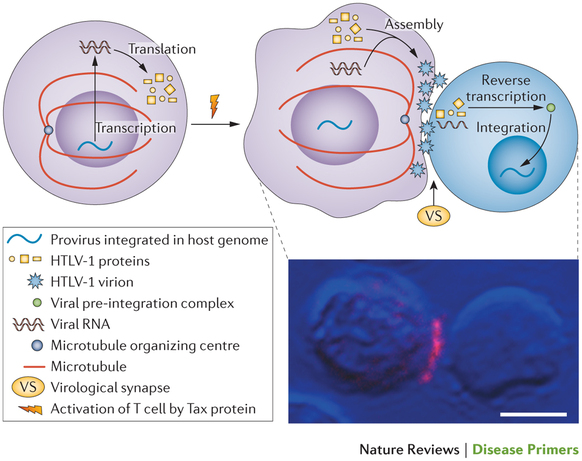Review Abstract
HTLV-1関連脊髄症/熱帯性痙性麻痺
HTLV-1-associated myelopathy/tropical spastic paraparesis
2015年6月18日 Nature Reviews Disease Primers Article number: 15012 (2015) doi: 10.1038/nrdp.2015.12

ヒトT細胞白血病ウイルス1型(HTLV-1)関連脊髄症/熱帯性痙性麻痺(HAM/TSP)は、下肢の筋力低下または麻痺、腰痛および尿路症状の原因となる中枢神経系の進行性疾患である。HAM/TSPが最初に報告されたのは19世紀のジャマイカであるが、この症状の病因がHTLV-1レトロウイルスによる感染であることが判明したのは1980年代に入ってからである。HAM/TSPは慢性障害を引き起こすため、HTLV-1感染症が風土病となっている地域では、大きな医療負担が強いられている。HAM/TSPの原因が発見されたため、HTLV-1感染症のウイルス学、免疫学、細胞生物学および病理学および関連疾患に関する理解は大きく進歩した。しかしその進歩にも限界がある。本疾患の正確な動物モデルがないからである。その上、HAM/TSPの治療は、極めて不十分なままである。抗レトロウイルス薬はHTLV-1感染症にほとんど無効で、効果が期待される疾患修飾薬が広く使用されているが、それらの有効性は証明されていない。現在のところ、臨床管理には対症療法とカウンセリングに重点が置かれている。本稿では、HAM/TSPの疫学、発症機序および治療法における最新の知見を要約し、さらなる研究が必要な領域を見定める。
Human T-lymphotropic virus 1 (HTLV-1)-associated myelopathy/tropical spastic paraparesis (HAM/TSP) is a progressive disease of the CNS that causes weakness or paralysis of the legs, lower back pain and urinary symptoms. HAM/TSP was first described in Jamaica in the nineteenth century, but the aetiology of the condition, infection with the retrovirus HTLV-1, was only identified in the 1980s. HAM/TSP causes chronic disability and, accordingly, imposes a substantial health burden in areas where HTLV-1 infection is endemic. Since the discovery of the cause of HAM/TSP, considerable advances have been made in the understanding of the virology, immunology, cell biology and pathology of HTLV-1 infection and its associated diseases. However, progress has been limited by the lack of accurate animal models of the disease. Moreover, the treatment of HAM/TSP remains highly unsatisfactory: antiretroviral drugs have little impact on the infection and, although potential disease-modifying therapies are widely used, their value is unproved. At present, clinical management is focused on symptomatic treatment and counselling. Here, we summarize current knowledge on the epidemiology, pathogenesis and treatment of HAM/TSP and identify areas in which further research is needed. For an illustrated summary of this Primer, visit: http://nature.asia/1NjaG40

